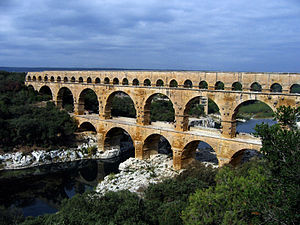Hydrosphere Contents
3. Water As A Resource
Historically, nations have flourished on a basis of advanced water resource development and nations and individuals have conflicted over water rights

Water has long been a precious commodity, with a clean and reliable water supply one of the most important factors for the success of any human population, ancient or modern.
For this reason, the earliest settlements were often near water bodies such as rivers, lakes or along the coastlines. Over time, humans learnt how to manage water to act provide a reliable and constant supply of water for human consumption and agriculture.
Examples of ancient water management systems include; the construction of aquaducts, bringing water from distant sources to local towns by the ancient Romans, the linking of the Tigris and the Euphrates in pre-Christian times by the Shatt el hai canal, the drainage works to control sheet flows to the Agora in Athens and the irrigation works of the pre-eminent 'hydraulic' civilisations of Sumeria and Egypt.
Conflicts have often arisen over water access rights. One of the first such examples was between the ancient Mesopotamium cities of Lagash and Umma. Both neighbouring cities situated between the Tigris and Euphrates, conflict arose when Lagash diverted water away from its neighbour.
Today, conflicts arise amongst people over shared water resources, such as the Nile. The Nile passes through 10 different countries before entering the Mediterranean sea. Egypt and Sudan are both extensive users of water from the Nile and there is much politics surrounding the equitable sharing of the water.
Can you give an example of an ancient civilisation's management of water?